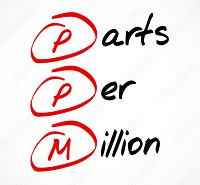What is the full form of PPMPPM: Parts Per Million
PPM Stands for Parts Per Million. The best way to express a substance's concentration or performance in a larger mixture is through the usage of PPM, or parts per million. This could be used to indicate water quality, the fault rate of a supplier, etc. Technically speaking, it is a dimensionless measurement that is represented as a percentage. It is better suited to characterizing lower concentrations of chemicals in gases, liquids, or solids; it is a ratio of two amounts of the same unit. One in a million, or ppm = 1 / 1,000,000 = 0.0001 percent of the total, is how one part in a million is stated in complete form. PPM Units1 ppm can be stated in a variety of ways depending on the chemical being tested. The preferred units for expressing ppm are milligrams per kilogram (mg/kg), microliters per liter (μL/L), and micrograms per liter (μg/L). A 10- gallon aquarium would require 1 million individual drops to fill it completely, for a better illustration. There are more useful techniques to describe ppm despite the fact that these conversions may be utilized in scientific applications. Consider the following ratios for 1 ppm:
Examples
Features
ImportanceThe concentrations of minerals and gases dissolved in water are measured using ppm in the water treatment process. To transfer heat, we employ water as a medium. These dissolved contaminants in ppm can lead to issues in the equipment such as mineral scale and corrosion as the water transmits heat. Depending on its properties, a mineral can only be dissolved in a certain number of parts per million of water. Then, when we alter the water's temperature and concentration, these minerals can try to leave the solution. To assist avoid these issues, we use treatment chemicals that are added and monitored in ppm.
Next TopicFull Form
|
 For Videos Join Our Youtube Channel: Join Now
For Videos Join Our Youtube Channel: Join Now
Feedback
- Send your Feedback to [email protected]
Help Others, Please Share










